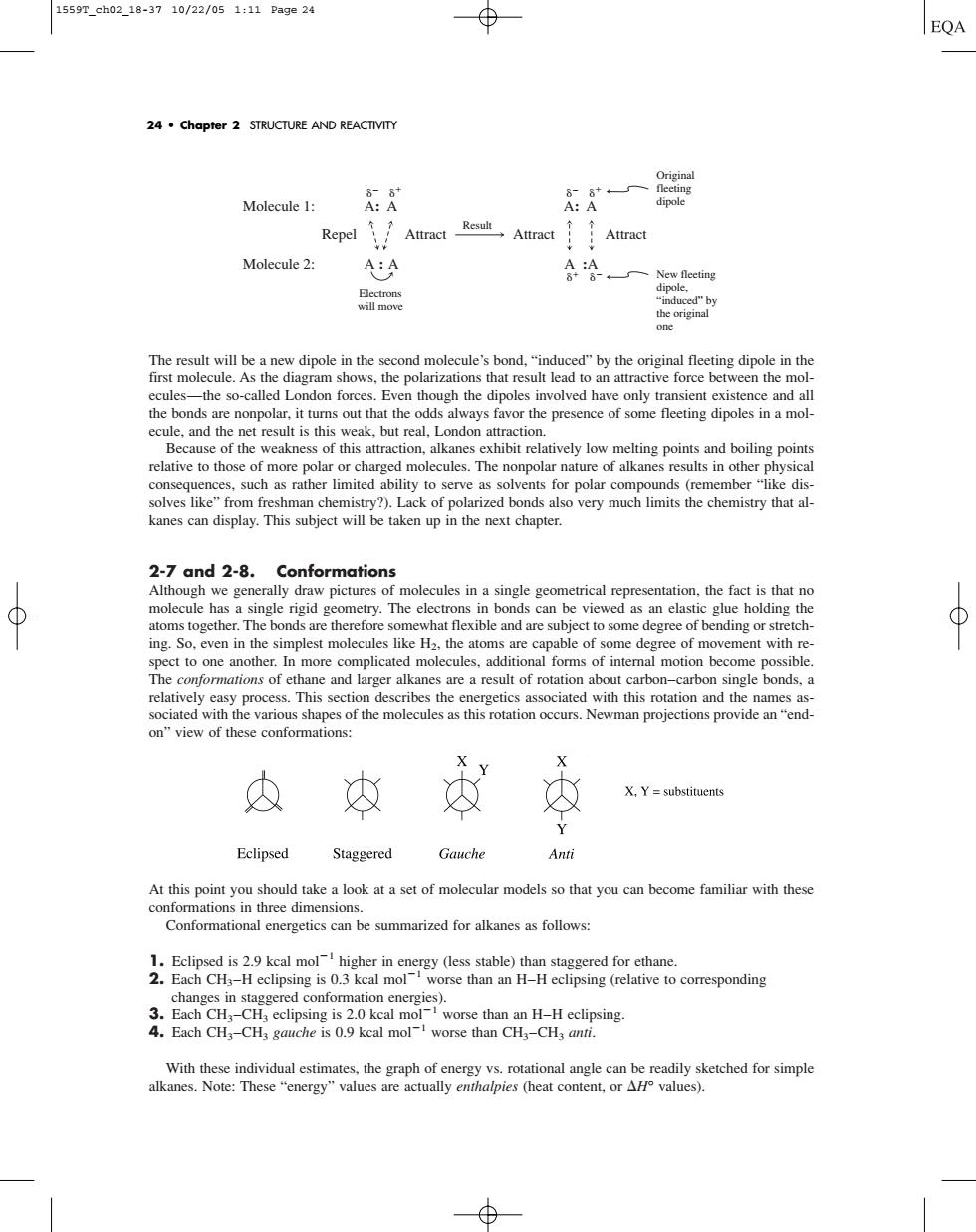正在加载图片...

1559Tch0218-3710/22/051:11Page24 EQA 24.chapter 2 STRUCTURE AND REACTIVITY Molecule 1: A:A Repel↑ Molecule2: A:A 人Ea电p道 ecules nonpola ims out that the od always favor the presence of some fleeting dipoles in a mol kanes can display.This subject will be taken up in the next chapter. 2-7and2-8. Conformations atoms together.The bonds are therefore somewhat flexible and are subject to some degree of bending or stretch ing.So,even in esimplest molecules like 10 degree of nt with on"view of these conformations X.Y=substituents Eclipsed Staggered Gauche Anti At this point you should take a look at a set of molecular models so that you can become familiar with these conformations in three dimensions Conformational energetics can be summarized for alkanes as follows: Each CH3-H eclipsing is 0.3 kcal mo worse than an H-H eclipsing (relative to corresponding 3.Each CHyCH eclipsing is 20 kcal molworse than an H-H eclipsing. 4.Each CHa-CHa gauche is 0.9 kcal mol worse than CH-CH3 anti. With these individual estimates,the graph of energy vs.rotational angle can be readily sketched for simple alkanes.Note:These "energy"values are actually enthalpies (heat content.or AH values).The result will be a new dipole in the second molecule’s bond, “induced” by the original fleeting dipole in the first molecule. As the diagram shows, the polarizations that result lead to an attractive force between the molecules—the so-called London forces. Even though the dipoles involved have only transient existence and all the bonds are nonpolar, it turns out that the odds always favor the presence of some fleeting dipoles in a molecule, and the net result is this weak, but real, London attraction. Because of the weakness of this attraction, alkanes exhibit relatively low melting points and boiling points relative to those of more polar or charged molecules. The nonpolar nature of alkanes results in other physical consequences, such as rather limited ability to serve as solvents for polar compounds (remember “like dissolves like” from freshman chemistry?). Lack of polarized bonds also very much limits the chemistry that alkanes can display. This subject will be taken up in the next chapter. 2-7 and 2-8. Conformations Although we generally draw pictures of molecules in a single geometrical representation, the fact is that no molecule has a single rigid geometry. The electrons in bonds can be viewed as an elastic glue holding the atoms together. The bonds are therefore somewhat flexible and are subject to some degree of bending or stretching. So, even in the simplest molecules like H2, the atoms are capable of some degree of movement with respect to one another. In more complicated molecules, additional forms of internal motion become possible. The conformations of ethane and larger alkanes are a result of rotation about carbon–carbon single bonds, a relatively easy process. This section describes the energetics associated with this rotation and the names associated with the various shapes of the molecules as this rotation occurs. Newman projections provide an “endon” view of these conformations: At this point you should take a look at a set of molecular models so that you can become familiar with these conformations in three dimensions. Conformational energetics can be summarized for alkanes as follows: 1. Eclipsed is 2.9 kcal mol1 higher in energy (less stable) than staggered for ethane. 2. Each CH3–H eclipsing is 0.3 kcal mol1 worse than an H–H eclipsing (relative to corresponding changes in staggered conformation energies). 3. Each CH3–CH3 eclipsing is 2.0 kcal mol1 worse than an H–H eclipsing. 4. Each CH3–CH3 gauche is 0.9 kcal mol1 worse than CH3–CH3 anti. With these individual estimates, the graph of energy vs. rotational angle can be readily sketched for simple alkanes. Note: These “energy” values are actually enthalpies (heat content, or H° values). A: A A : A A :A Original fleeting dipole New fleeting dipole, “induced” by the original one Result Repel Attract Molecule 1: Molecule 2: Attract Attract A: A Electrons will move 24 • Chapter 2 STRUCTURE AND REACTIVITY 1559T_ch02_18-37 10/22/05 1:11 Page 24�